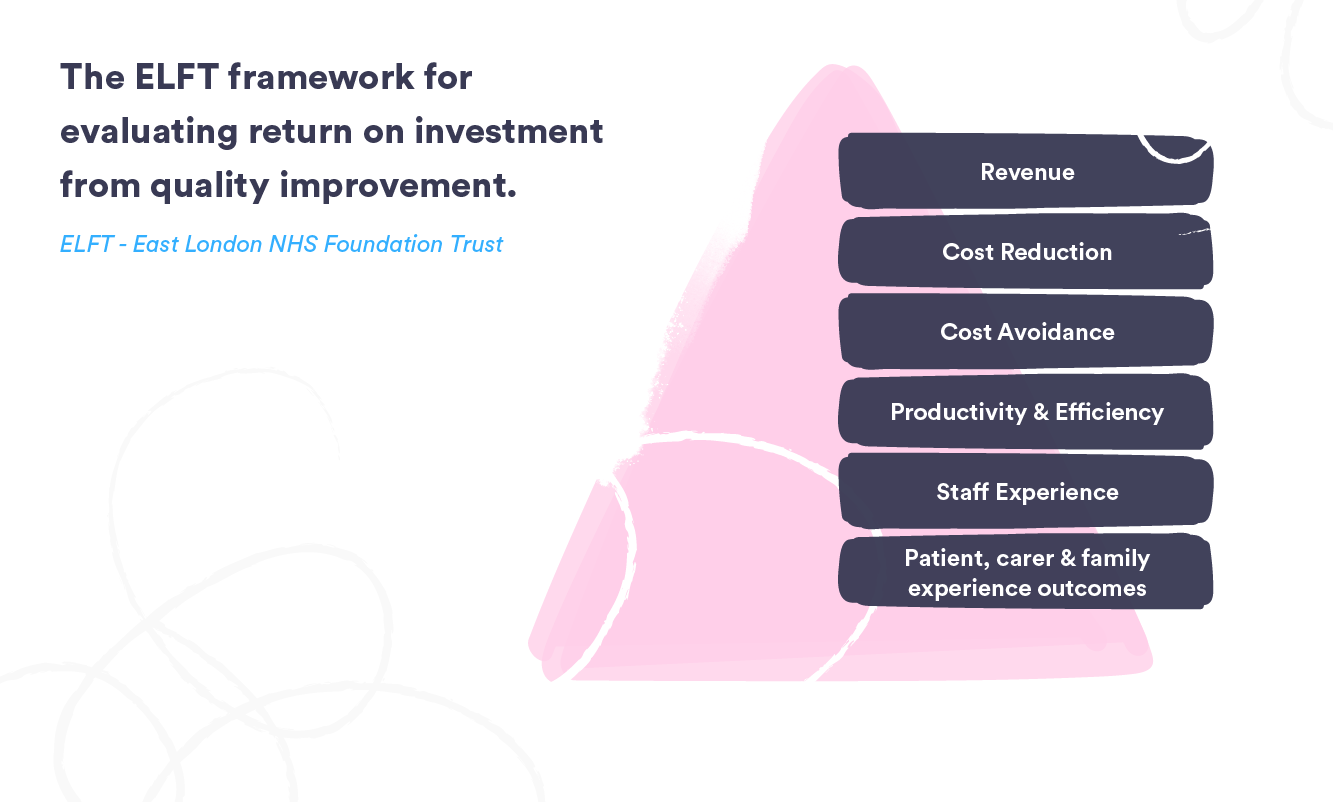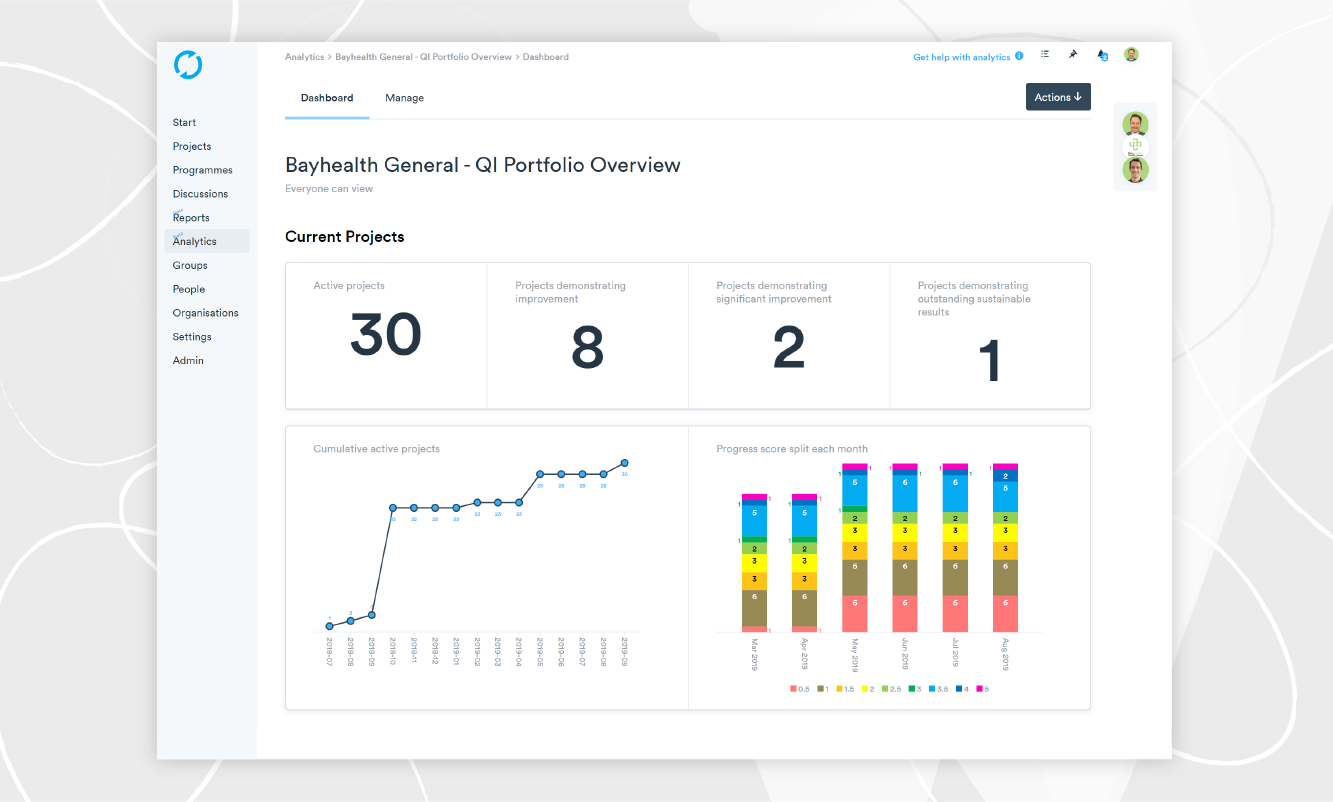Start improving with Life QI today
Full access to all Life QI features and a support team excited to help you. Quality improvement has never been easier.

Organisation already using Life QI?
Sign-up

There is increasing confidence and evidence that quality improvement (QI) methods can be used to address complex healthcare challenges. As the prevalence of QI within healthcare organisations grows and investment in building improvement capability increases, QI teams are increasingly being asked to demonstrate the return on investment (ROI) of their efforts to address healthcare challenges. And rightly so, as the level of investment increases, so do the expectations for returns that validate the investment, especially in highly financial constrained health systems.
Despite the increasing prevalence of QI teams, programmes and senior quality executives, there remains little guidance and defined mechanisms for tracking the ROI of QI work. This article presents our insights into how this can be done based on the literature and our experiences of working with healthcare organisations around the world.
The results from healthcare improvement projects include both financial and non-financial benefits. Whilst financial benefits are often first in line because of the immediate cost attachment, non-financial returns are just as important, often more so, and shouldn't go unnoticed. Return on Investment (ROI) is the commonly used term for measuring the impact of initiatives that have been invested in. It typically has a financially focused lens with which return is measured. Less commonly understood is the VOI (Value on Investment) concept, first introduced by Gartner (the world’s leading information technology research and advisory company). Gartner propose that a wide range of factors influence value and can play a pivotal role in contributing to an organisation’s performance and can in turn contribute to traditionally financially focused ROI.
VOI encompasses aspects such as staff engagement, staff morale, knowledge sharing, the ability to collaborate, clear processes and systems, customer perceptions and experiences, productivity, and efficiency.
This VOI approach is mirrored by the East London NHS Foundation Trust (ELFT) framework for evaluating ROI from quality improvement (Shah and Course, 2018*). The ELFT framework places primacy on elements such as patient, carer and family experience outcomes, and staff experience. There can be financial elements to gains in these areas, but focus should also be given to the non-financial benefits, such as staff satisfaction and engagement rates.

Understanding and monitoring outcomes is the ultimate measure of impact and return. However, often these will be lagging measures, i.e. you don’t know about them until after they have happened. So it is also useful to track leading measures to provide signals that the improvement work will lead to positive outcomes.
A range of activity and progress measures can be used as leading measures. Numbers of projects being run, numbers of projects demonstrating improvement, numbers of projects completed having demonstrated improvement, number of staff engaged in QI projects, to name but a few. Defining your leading measures and having a resource efficient reporting process in place will make the regular capture and monitoring of these measures simple. From which you can easily monitor trends in these leading measures for signals of increasing or decreasing patterns of improvement, and thus return/value.
Taking this a step further you may even consider monitoring such measures using statistical process control (SPC) charts to spot where interventions in your improvement capability result in statistically significant improvements in these measures, which would in turn lead to significant returns from the improvement projects being run.
Project outcome measures, aligned to project aim statements, should be a key source of data for tracking the return of improvement efforts.
If guidance and governance is given to ensuring projects are aligned to organisational priorities, then the outcome measures being monitored during projects should nicely align with wider organisational objectives. The aggregation of common outcome measures from multiple QI projects will provide an overarching view of improvements being delivered from across the organisation for each priority outcome measure.
When assessing the impact and trends of a range of improvement projects it is useful to have a universal guide to denote progress towards whatever improvement goal has been set. This allows multiple projects to be rapidly assessed and grouped to easily identify those demonstrating improvement, not yet demonstrating improvement, and those focusing on implementation of proven improvements.
The IHI project progress score scale does just this. As a 10-point scale it allows teams to grade their progress right from ‘intent to participate’ in a project through to ‘outstanding sustainable results’. This article explains the scale in more detail.
Effective use of this scale allows managers and execs to accurately monitor progress of improvement efforts on a project by project basis. Dashboards can be used to track key metrics at the relevant levels within the organisation. For example, a divisional manager can easily monitor how many of her projects are demonstrating improvement at any point in time, how many projects have stalled, and how many projects have successfully completed in the last 30 days. Having this data at your finger tips not only allows you to evidence the return being made by this work, but also the opportunity to spot and intervene on projects that have stalled and risk not fulfilling their potential.
Some, but a relatively small number of people within the organisation, will be interested in what is happening at the organisation-level. Most people are primarily concerned about what is happening at their more local, divisional or departmental level. So, setup a monitoring infrastructure that provides people with the information relevant to their parts of the organisation.
They will use this to drive further improvement locally and be able to see the impact on their local improvement metrics. The overall ROI/VOI of the organisation’s improvement efforts will be enhanced if those responsible for specific operational areas can monitor and evidence their specific results. With operational responsibility and monitoring structures in place locally, the total effect at the organisational level can be profound.
Firstly, decide on the metrics that matter to your organisation, but do so at multiple levels.
Secondly, give your Life QI Success Manager a call to get your desired monitoring metrics and structure setup for you in Life QI. All of the aspects described here can be setup for easy monitoring in Life QI.

* Shah A and Course S, Building the business case for quality improvement: a framework for evaluating return on investment, Future Healthcare Journal, 2018; 5:132-7
Full access to all Life QI features and a support team excited to help you. Quality improvement has never been easier.

Organisation already using Life QI?
Sign-up


.png)


